![]()
![]()
![]()
Use LEFT and RIGHT arrow keys to navigate between flashcards;
Use UP and DOWN arrow keys to flip the card;
H to show hint;
A reads text to speech;
17 Cards in this Set
- Front
- Back
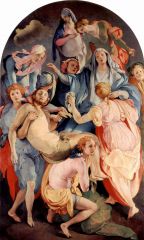
|
Pontormo
The Entombment or Deposition of Christ (1525-1528) Florence |
|
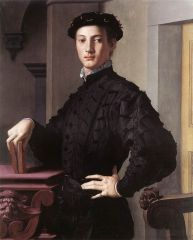
|
Bronzino
Portrait of a Young Man (c. 1530-1545) Florence Performance; Mask |
|
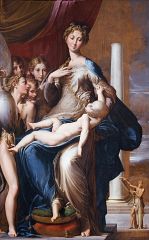
|
Parmigianino
Madonna with the long Neck (1534-1540) Parma column refers to the Virgin Mary |
|
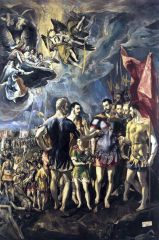
|
El Greco
Martyrdom of Saint Maurice and the Theban Legion (1580-82) For the Escorial Rejected by Philip II for its lack of Decorum, wasn’t considered appropriate for Counter-Reformation ideals - No clarity of message, martyrdom is represented in the corner, not dignified. |
|
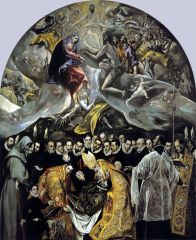
|
El Greco
Burial of the Count of Orgaz, 1586-88 for church in Toledo more in tune with Counter-Reformation ideals: Represents the apparition of St. Augustine and St. Stephen during the burial of a 14th century Toledan nobleman; Emphasizes Catholic view on Good works as essential for salvation |
|

|
Annibale Carracci
Loves of the Gods (1597-1601) Farnese Gallery, Rome Commissioned by Cardinal Farnese; Possibly commemorates marriage of Cardinal’s brother; decorates a room that was used as an art gallery: Quadro Riportato: simulated easel paintings; Illusionism: Awe, Wonder |
|
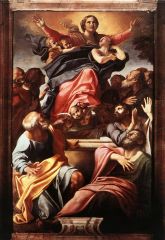
|
Annibale Carracci
Assumption of the Virgin (1601) Private chapel in church in Rome compare to Caravaggio, Crucifixion of St. Peter, in the same chapel (Rome, c. 1601) |
|
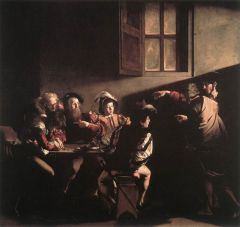
|
Caravaggio
Calling of St. Matthew (c. 1597-1601) Private chapel in church in Rome Including individuals with contemporary dress - makes the painting more approachable. |
|

|
Caravaggio
Crucifixion of St. Peter (c. 1601) Private chapel in church in Rome Compare to Annibale Carracci, Assumption of the Virgin, in the same chapel, (Rome c. 1601). |
|
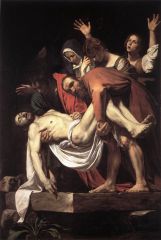
|
Caravaggio
Entombment (c. 1603) Private chapel in church in Rome Transubstantiation: the transformation of the Eucharistic bread and wine into the body and blood of Christ |
|

|
Bernini
Apollo and Daphne (1622-4) Galleria Borghese, Rome Was displayed in a room used as art gallery; showpiece for Bernini; theme from Ovid’s Methamorphoses; Awe, Surprise, Wonder |
|
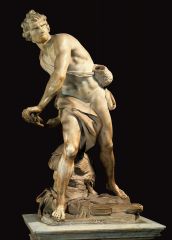
|
Bernini
David (1623-4) Galleria Borghese, Rome Compare to Michelangelo, David (1501-1504); Donatello, David (c. 1440-1460) |
|
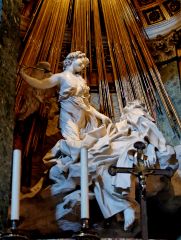
|
Bernini
Ecstasi of Saint Teresa (1645-52) (Chapel in church in Rome Represents Saint Teresa of Avila, a Spanish mystic known for her visions and trances who had just become saint in 1622: Great example of Baroque’s interest in psychology, the representation of extreme feelings, and the sense of infinite through light; theatrical elements; Bel composto - different elements of art in one work (use of sculpture, painting, and architecture, also light) |
|
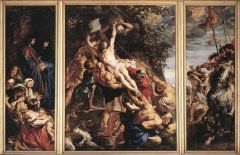
|
Rubens
The Raising of the Cross (1610-11) Antwerp, Flanders/Belgium Triptych; life model; ancient sculptures (Laocoon); created after oil sketch |
|
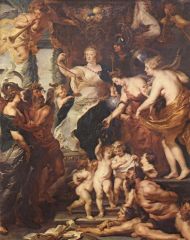
|
The Marie de’ Medici Cycle (c.1621-1625)
Paris, France |
|
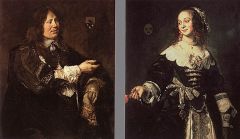
|
Frans Hals
Pendant Portraits of Married Couple (Stephanus Geraerdts and Isabella Coymaus) (1650-52) Pendants (meant to be displayed next to each other), follows some of the typical conventions of portraiture: pale woman (inside the home); darker-skinned man (works outside); woman at the left of the man (lesser side). Also offers some innovations (more informal; intimacy between the couple; Calvinist ideas of marriage for love; lose brushwork) |
|
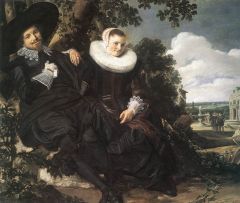
|
Frans Hals
Double Marriage Portrait (of Isaac Massa and Beatrix van der Laen) (c. 1622) Double portrait: even more intimate; informal poses; Calvinist ideas of marriage for love; landscape setting; lose brushwork) |

